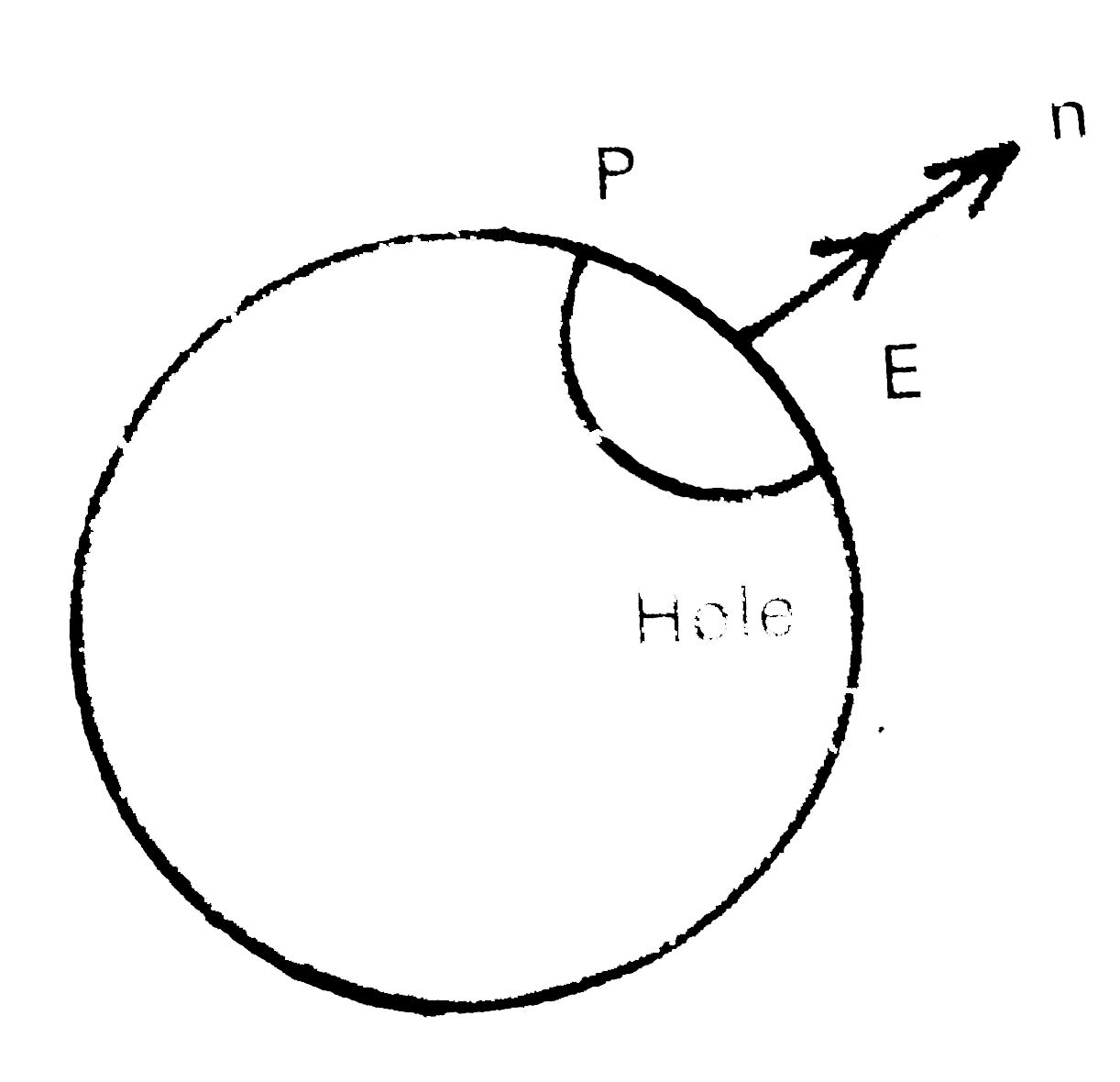A hollow charged conductor has a tiny hole cut into its surface. Show that the electric field in the hole is (σ/εε0)ˆn, where ˆn is the unit vector in the outward normal direction and σ is the surface charge density near the hole.
Surface charge density near the hole =σ
Unit vector =ˆn (normal directed outwards)
Let P be the point on the hole
the electric field at point P closed to the surface of conductor, according to Gauss's theorem,
∮E.dS=qε0
where q is the charge near the hole.
Edscosθ=σdSε0(∵σ=qdS∴q=σdS) where dS= area
∵ Angle between electric field and area vector is 0∘.
EdS=σdSε0
E=σε0
E=σε0ˆn
This electric field is due to the filled up hole and the field due to the rest of the charged conductor. The two fields inside the conductor are equal and opposite. So, there is no electric field inside the conductor. Outside the conductor, the electric fields are equal and area in the same direction.
So, the electric field at P due to each part =12E=σ2ε0ˆn

Topper's Solved these Questions
- ELECTRIC CHARGES AND FIELDSBOOK - VIKRAM PUBLICATION ( ANDHRA PUBLICATION)CHAPTER - ELECTRIC CHARGES AND FIELDSEXERCISE - DAM SURE VSAQ
17 Videos
- ELECTRIC CHARGES AND FIELDSBOOK - VIKRAM PUBLICATION ( ANDHRA PUBLICATION)CHAPTER - ELECTRIC CHARGES AND FIELDSEXERCISE - DAM SURE LAQ
1 Videos
- ELECTRIC CHARGES AND FIELDSBOOK - VIKRAM PUBLICATION ( ANDHRA PUBLICATION)CHAPTER - ELECTRIC CHARGES AND FIELDSEXERCISE - TEXTUAL EXERCISES
11 Videos
- DUAL NATURE OF RADIATION AND MATTERBOOK - VIKRAM PUBLICATION ( ANDHRA PUBLICATION)CHAPTER - DUAL NATURE OF RADIATION AND MATTEREXERCISE - DAM SURE (VSAQ)
2 Videos
- ELECTROMAGNETIC INDUCTION BOOK - VIKRAM PUBLICATION ( ANDHRA PUBLICATION)CHAPTER - ELECTROMAGNETIC INDUCTION EXERCISE - Additional EXERCISES
15 Videos
Similar Questions
A hollow charged conductor has a tiny hole cut into its surface. Show that the electric field in the holes is (σ/2ε0) ˆn, where ˆn is the unit vector in the outward normal direction, and σ is the surface charge density near the hole.
View SolutionA hollow charged conductor has a tiny hole cut into its surface. Show that the electric field in the holes is (σ/2∈0() ˆn, where ˆn is the unit vector in the outward normal direction, and σ is the surface charge density near ther hole.
View Solution
Knowledge Check
The electric intensity at a point near a charged conductor of surface charge density σ is
AE=σ/∈0kBE=σ∈0kCE=σ/2∈0kDE=σ2
A hollow charged conductor has a tiny hole cut into its surface. Show that the electric field in the holes is (σ/2∈0 ˆn, where ˆn is the unit vector in the outward normal direction, and σ is the surface charge density near ther hole.
View SolutionA hollow charged conductor has a tiny hole cut into its surface. Show that the electric field in the hole is (σ2∈0)ˆn , where ˆn is the unit vector in the outward normal direction, and σ is the surface charge density near the hole,
View SolutionShow that the electric field at the surface of a charged conductor is proportional to the surface charge density.
View SolutionShow that the normal component of electrostatic field has a discontinuly form one side of a charged. Surface to another given by (−→E2−−→E1).ˆn=σ∈0
where ˆn is a unit vector normal to the surface at a point and σ at a point and σ is the surface charge density at that point. (The direction of ˆn is from side 1 to side 2). Hence show that justy outside a conductor, the electric field σˆn/∈0.
(b) Show that the tangential componet of electrostatic field is contionous from one side fo a charged surface to another.
View SolutionShow that the normal component of electrostatic field has a discontinuity from one side of a charged surface to another given by
(→E2−→E1).Htan=σε0
where ˆn is a unit vector normal to the surface at a point and o is the surface charge density at that point. (The direction of în is from side 1 to side 2). Hence, show that just outside a conductor, the electric field is σε0ˆn.
View SolutionShow that the electric field at the surface of a charged conductor is given by →E=σε0ˆn , where σ is the surface charge density and ˆn is a unit vector normal to the surface in the outward direction .
View SolutionShow that the electric field at the surface of a charged conductor is given by →E=σε0ˆn , where σ is the surface charge density and ˆn is a unit vector normal to the surface in the outward direction .
View Solution
